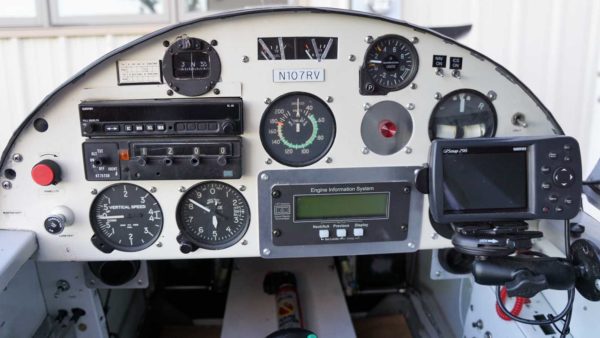Having been away from the poor RV-4 for a while, some maintenance was necessary.
When I purchased the airplane it had some very old fuel level gauges. One fuel tank in each wing so two gauges. These can be seen at the top-center of the panel in the following photo.
Neither of them has ever worked very well, at least for as long as I’ve owned her. I’ve attempted to add some meaningful markings but it was wasted effort.
The Engine Information System (EIS) that I installed earlier this year (here – and shown in the above photo) includes the ability to display fuel level. Yay!
I did not previously have the time to do the necessary re-wiring and EIS setup – I did a few weeks ago!!
The wiring is pretty simple. A 4.8VDC excitation ‘power’ source ran thru a 470 ohm resistor and then to the EIS – for each tank. The EIS is configured with some default values just to get the ball rolling.
The part that takes a while is the calibration. You must drain the right tank all the way to empty, record what the EIS reports, fill the tank, record what the EIS reports, and then… oh wait…
The EIS is recording backwards… change a forward/reverse setting in the EIS and start over again…
Drain the right tank, record what the EIS reports, fill the tank, record what the EIS reports, do some quick math, and then plug new configuration values into the EIS.
Repeat for the left tank.
There is no easy way to empty a fuel tank so I disconnected the fuel line at the carburetor and used the onboard electric fuel boost pump to pump all the fuel out.
Yes, that takes a while. Hours actually…
In hindsight, I should have went flying, burned off some of that fuel, and started with a near empty tank.
Ahh… that would not have mattered though because of the whole forward/reverse setting.
Oh well… it was all good fun.
The EIS is reporting how much fuel is actually in the tank.
That will be a welcome improvement!!
The carb heat cable was acting up so it was replaced with a new one. As with most things, a five minute job turns into five hours.
Ok, not five hours, in this case but significantly more than five minutes!
The hole in the carb heat flapper arm was elongated and needed repaired. Looking at the hardware, it was obvious that a very poor fit and lots of hours of operation had caused this. So, some new mounting hardware, new cable, repaired flapper arm, and we are back in business!
I had also intended to install a fuel flow sensor in the fuel line. This sensor connects to the EIS and displays the fuel flow while flying. This is a much debated thing in the aviation world. I’ve found this information to be useful and wanted it in this airplane.
To accomplish this sensor install, I needed to make a couple of new sections of fuel line. This isn’t just rubber fuel hose connected with hose clamps. No, sorry… it is quality aircraft hose with screw on AN fitting on each end. Previous to this effort, I attempted to order all of the bits that I expected to need.
There is hope that I am getting less dumb as the first thing I did was lay out all these hose bits to confirm I had what I needed.
I didn’t!
However; right then was a good time to discover this!! Before I had torn everything apart! Yay me!! 🙂
So, this sensor didn’t get installed but the necessary parts have been ordered and it will happen soon.
The final bit of maintenance was replacing a few anchor nuts that had broken or were missing and just some typical wear and tear type stuff.



Good to hear you are improving your RV. Fuel gages only have to be correct at Empty and Full but knowing in between is handy. I always used estimated fuel burn and never ran out. I did once land in a friends C-172 and have to coast off the runway. That was a bit disconcerting for me.
Carb air boxes are not made to last long, poor bearings and flapper attachment were failure points. I do envy your flying adventures. I am at the point where I miss having a plane and a medical to fly it.
Thanks for keeping us up to date on airplane stuff.